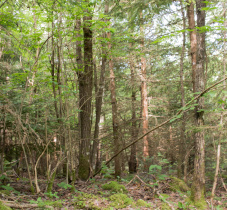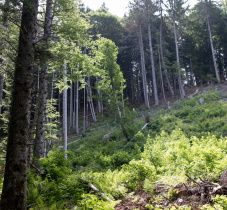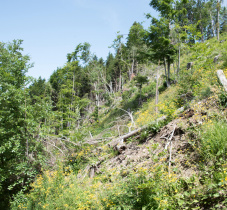Project description
Take part in supporting the natural regeneration of this forest in Haute-Savoie !
The project at a glance
- Number of trees to be financed: 29,100
- Area of the operation: 19 hectares
- Main species enhanced: spruce, fir, sycamore maple, larch, wild cherry, mountain ash
- Project type: support for natural regeneration of the massif
- Regeneration season: 2022-2024
- Region: Auvergne-Rhône-Alpes
- Certification: PEFC
The origin of the project
In Haute Savoie, this project is located in the alpine foothills at an altitude of over 1000m. This forest was mainly composed of spruce and spontaneous hardwoods. In the understory, many species are present, and are not able to develop today because of lack of light or because they are too dense.
The objective of this project is to allow these young trees to develop, by reducing competition and promoting their access to light. The owner will favor species that are not well represented, in order to let the diversity express itself as much as possible. Enrichment plantings will also be planned to introduce new species. This forest will then be better adapted to climate change, and its irregular structure will allow for management without clear-cutting, bringing many benefits for biodiversity as well as for the soil and the landscape.
The Assisted Natural Regeneration
Assisted Natural Regeneration (ANR) is a natural method that helps preserve and strengthen existing forests through management that combines the trees’ natural reproduction cycle with silviculture work. To find out more about our ANR projects, read our brochure or watch the explanatory video.
Generated benefits
-
Fight against climate change: trees provide fruit, fodder, wood, resins, tannins etc. Once planted, they regulate temperatures through the shade of their foliage. Carbon sinks, they store CO₂ and are valuable allies in the fight against global warming. They restore soil fertility and prevent soil erosion.
-
Development of biodiversity: agroforestry promotes biodiversity and provides multiple habitats and species. Micro-organisms, fauna and flora participate in the restoration of an ecological network. They provide refuges for birds that regulate pest populations on crops.
-
Protection of territories: the trees regenerated in agroforestry help to protect the land from extreme weather events. By creating shaded areas, the trees preserve the crops during the dry season and provide them with a protective cover during the rainy season.
-
Soil enrichment: the leaves fallen from the trees will allow the creation of organic matter that will enrich the soils and contribute to the proper functioning of the forest ecosystem.
-
Wood supply: eventually, some mature trees may be harvested to supply the timber industry, economic lung that needs to operate a sustainable energy transition.
-
Soil nutrition: trees retain rainwater on the soil surface and filter it before it enters the water table. Thus, forest canopies regulate the water cycle and help preserve the planet's water resources.






